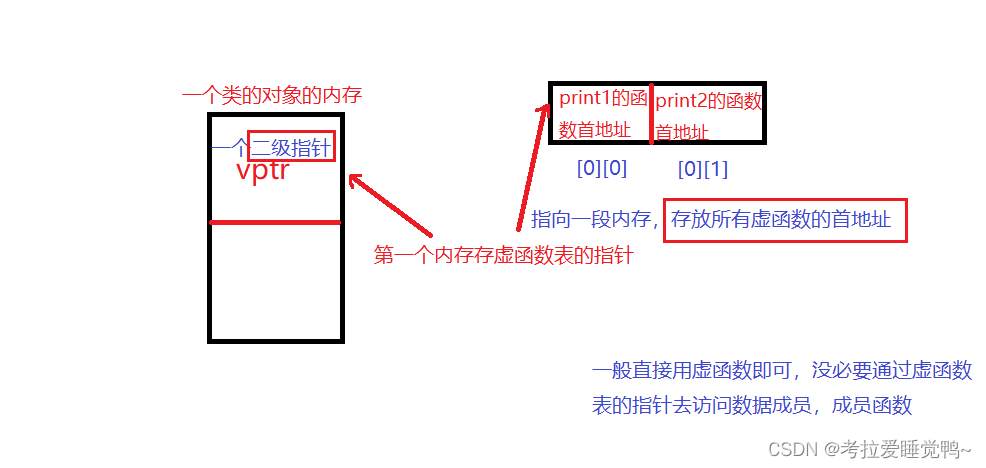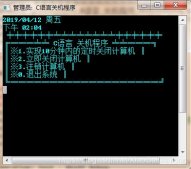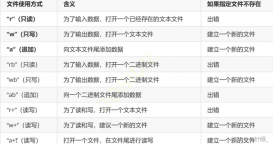1.什么是虚函数?
用virtual 修饰的成员函数叫虚函数
小知识: 没有虚构造函数 不写虚函数,没有默认的虚函数
普通函数不影响类的内存:
|
1
2
3
4
5
6
7
8
9
10
11
12
13
14
15
16
17
18
19
20
21
22
23
24
|
class MM{public: void print() { cout << "普通函数"<< endl; //普通函数不影响类的内存<--->普通函数存在另一段内存中 }protected:};void testVirtual(){ //C语言不允许存在空的结构体 cout << sizeof(MM) << endl;/*(没有数据成员的)空的类或者结构体 占用1字节 用1字节标识当 前内存为结构体内存*/}int main() { testVirtual(); return 0;}/*输出*//* 1 */ |
2.虚函数会影响类的内存
增加一个指针的内存,32位操作系统多4个字节 ,64位操作系统多8个字节
|
1
2
3
4
5
6
7
8
9
10
11
12
13
14
15
16
17
18
19
20
21
22
23
24
25
26
27
28
29
|
#include <iostream>using namespace std;class MM{public: virtual void print1() { cout << "虚函数1"<< endl; } /*virtual void print2() { cout << "虚函数2" << endl; } 无论多少个虚函数,增加的字节就是一个指针的字节--->多了一个虚函数,还是4个字节*/protected:};void testVirtual(){ cout << sizeof(MM) << endl; }int main() { testVirtual(); return 0;}/*输出*//* 4 */ |
小知识:一旦有了数据,标识位就不需要存在了
|
1
2
3
4
5
6
7
8
9
10
11
12
13
14
15
16
17
18
19
20
21
22
23
24
|
class A{ int num; //输出4而不是5 (4+1)};class B{ //用1字节标识当前内存为结构体内存};void testVirtual(){ cout << sizeof(A) << endl; cout << sizeof(B) << endl;}int main(){ testVirtual(); return 0;}/*输出*//*4 1*/ |
3.了解虚函数表--->通过虚函数表的指针去访问数据
就是一个指针存储所有虚函数的首地址(虚函数函数名)<--->函数指针
只有指针可以操作一段内存(4字节)
/*无论多少个虚函数,增加的字节就是一个指针的字节*/
所有的虚函数其实是 用一个函数指针去存储的 ,把 这个函数指针指向的这一段内存 称为虚函数表

|
1
2
3
4
5
6
7
8
9
10
11
12
13
14
15
16
17
18
19
20
21
22
23
24
25
26
27
28
29
30
31
32
33
34
35
36
|
#include <iostream>using namespace std;class MM{public: virtual void print1() { cout << "虚函数1"<< endl; } virtual void print2() { cout << "虚函数2"<< endl; } protected:};void testVirtual(){//虚函数表 MM mm; //构建一个对象 int** vptr = (int** )&mm; //定义一个二级指针&对象的地址 强转类型 typedef void(*PF)(); //函数指针定义别名 PF func = (PF)vptr[0][0]; //把地址转为函数指针,访问第一个函数指针的地址 func(); //通过虚函数表的函数指针调用第一个虚函数 func = (PF)vptr[0][1]; func(); //调用第二个虚函数}int main() { testVirtual(); return 0;}/*输出*//*虚函数1 虚函数2*/ |
4.虚函数声明
虚函数可以在类中声明,在类外实现,不再需要virtual修饰词,只要类名限定就可以了
|
1
2
3
4
5
6
7
8
9
10
11
12
13
14
15
16
17
18
19
20
|
class MM{public: virtual void print3(); protected:};void MM::print3() { cout << "虚函数3" << endl;}int main(){ MM mm; mm.print3(); return 0;}/*输出*//*虚函数3*/ |
到此这篇关于c++虚函数与虚函数表原理的文章就介绍到这了,更多相关c++虚函数与虚函数表内容请搜索服务器之家以前的文章或继续浏览下面的相关文章希望大家以后多多支持服务器之家!
原文链接:https://blog.csdn.net/weixin_60569662/article/details/121722479
















